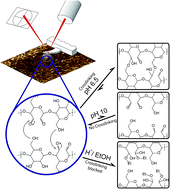On the mechanism behind freezing-induced chemical crosslinking in ice-templated cellulose nanofibril aerogels†
Abstract
The underlying mechanism related to freezing-induced crosslinking of aldehyde-containing cellulose nanofibrils (CNFs) has been investigated, and the critical parameters behind this process have been identified. The aldehydes introduced by periodate oxidation allows for formation of hemiacetal bonds between the CNFs provided the fibrils are in sufficiently close contact before the water is removed. This is achieved during the freezing process where the cellulose components are initially separated, and the growth of ice crystals forces the CNFs to come into contact in the thin lamellae between the ice crystals. The crosslinked 3-D structure of the CNFs can subsequently be dried under ambient conditions after solvent exchange and still maintain a remarkably low density of 35 kg m−3, i.e. a porosity greater than 98%. A lower critical amount of aldehydes, 0.6 mmol g−1, was found necessary in order to generate a crosslinked 3-D CNF structure of sufficient strength not to collapse during the ambient drying. The chemical stability of the 3-D structure can be further enhanced by converting the hemiacetals to acetals by treatment with an alcohol under acidic conditions.



 Please wait while we load your content...
Please wait while we load your content...